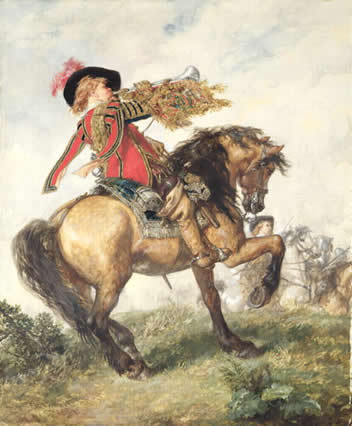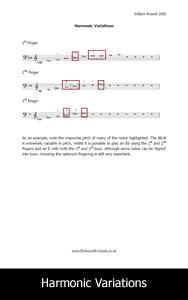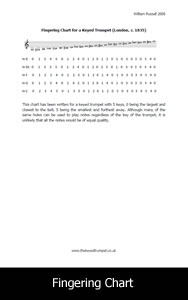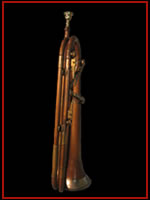Background Research
This part of the website is intended to support the main body of the research. You may wish to read through the information here to gain a broader knowledge of the subject as a whole. Alternatively, links within the main text will direct you to the relevant sections when you may find them most useful.
What is a keyed trumpet?
The keyed trumpet is essentially a natural trumpet in the key of E flat, although instruments in alternate pitches, most often pitched in G or A flat, have also been discovered. It is twice the length of a modern trumpet of the same pitch and is looped three times to make it a more practical length for performance. It commonly has three or four keys which raise the pitch by a semi-tone, tone, tone and a half and, in the case of a fourth key, by two whole tones. The holes themselves are covered by leather pads attached to spring mounted keys and arranged so they may all be operated by one hand.
As a basic guide, all German and Austrian keyed trumpets are played with the left hand, whilst those made in Italy use the right, although exceptions to this rule have been discovered. At the time of the instrument’s conception, the trumpet was an instrument used by the cavalry. David Edwards, himself a former cavalryman, was keen to point out a possible reason for this;
The reins of a horse were traditionally held in the left hand, leaving the right to hold a weapon. In the case of the military trumpeter, he would replace his weapon with his trumpet, holding it in the right hand. As such, trumpeters were used to holding the instrument with the right hand, leaving the left free when not riding. This meant that it would have been most natural, for the free hand to operate the keys.

The instrument was designed to overcome the limitations of the natural harmonic series and became the first trumpet to be capable of playing accurately and with an even tone, an entire chromatic scale throughout its working range. Although no instruments contemporary to Haydn’s concerto have been found in E flat, it is most probable that this was the pitch of Anton Weidinger’s keyed trumpet, as E flat was the standard pitch of Austrian military trumpets at that time.

My trumpet
The trumpet I have used for this research was made by David Edwards in 1998, after a keyed trumpet by Josef Riedl, circa 1796 in Vienna. It is made from copper and has four keys, operated with the right hand (to allow ease of playing for modern trumpeters used to operating valves with this hand). It takes a baroque mouthpiece although I have been able to use my modern one with a view to experimenting more with this in the future. I am extremely grateful to David Edwards for the loan of this instrument and for the length of time he has allowed me to use the trumpet for my research.

What do the holes do?
The holes are bored into the tubing at specific points where nodes occur in the sound waves produced by playing. When the key covering them is lifted, air is vented from the instrument at a certain nodel point, shortening the vibrating air column and raising the pitch of the note. The precise change in pitch that occurs will be dependent on the position of the hole in relation to the overall length of the instrument.
Each hole allows the next harmonic series to be played when it is opened, allowing in turn, all the notes of the chromatic scale to become available. Discover more. However, the holes are not entirely capable of giving uniform pitch throughout the register and so several notes require more precise tuning with the lips. This technique, often known as ‘lipping’ would have been second nature to trumpet players from the Baroque and Classical periods and is mentioned extensively by Girolamo Fantini (1638) and Johann Ernst Altenburg (1795).
Some notes, for example Bb’ and Eb” occur in several harmonic series, although usually one or more of the duplicate notes is a note of inferior tone or intonation. As a result, different key combinations are therefore available to the performer. Interestingly, a particular note may sound better in one tonality than another, depending on the choice of fingering used.

Like the valves on a modern trumpet, each hole is never entirely accurate for all the notes of the scale. (The first and third valves on the modern trumpet have individual tuning slides to compensate for this, whilst the keyed trumpet lacks any method for altering pitch in this way). The notes from each harmonic series are more precisely centred on the instrument in the lower range. The fourth hole in the tubing, being furthest from the bell, produces the least accurate harmonic series, regardless of the register it is employed in.
The higher we play in the harmonic series, the closer together become the harmonics and we rapidly lose the precision of pitch afforded by opening a specific hole. In other words, as we play in the highest portion of the instruments range, opening or closing a hole will have little or no effect on the pitch produced. As a result of these problems, the instrument, although chromatic, works best in its home key (in this case E flat).
One of the biggest draw backs of the holed system is that once a crook is used to lower the pitch of the entire instrument (in other words changing the instrument into a trumpet in G or A flat) the holes no longer correspond with the position of the nodes caused by the vibrating air column. Naturally, this prevents any real pitches being formed, other than those from the harmonic series corresponding to the new length of the instrument. Alternatively, some keys will share nodel positions with others. In this case opening the tone holes will have an effect, and by using different fingerings, a performer can more precisely change the key of his entire instrument. Unfortunately this requires the player to learn a new set of fingerings for each new key, a complex procedure soon made unnecessary with the invention of the valve, in around 1820.

Slight differences in tone are caused by the holed system as air is effectively leaked to create the pitch whilst the air sent through the valves on a modern instrument is contained, helping to create a uniform tone quality. The holes nearest the bell are larger than those furthest away and allow a more centred and secure sound to be produced.
As a final note, having four keys on the instrument allows five harmonic series to be played (if we include the harmonic series available with no holes open at all). It is from this scope of five different series that all the notes of the chromatic scale can be drawn. Discover more. The more keys the instrument has, the more harmonic series become available (up to a maximum of seven), and more combinations of fingerings can be found, increasing the potential for an optimum fingering. However, once the valve was invented, the three valve system producing seven different combinations and therefore seven harmonic series, the holed system became obsolete.

Initial Observations
After my first few experiments with the instrument I wrote a brief list of my observations to maintain a permanent record of what I was finding out. Whilst writing, further questions presented themselves and it is through this ongoing process of practice and reflection that I am developing my knowledge of the subject as a whole.
- The sound is quite warm like a flugel horn, and is much purer in the high register.
- The fourth key works well for the B natural above and below the stave but not on it. Unlike valves, there is no key that works for a given note in every octave.
- The A on the stave is a poor note at the minute, may be another combination exists for this (1+2)?
- Low register needs further exploration although there is a good pedal C (1st partial)
- With all the holes closed the instrument plays like a natural trumpet in E flat
- What kind of attack is best? So far my attack has been quite heavy, perhaps a softer tongue will give better results?
- Louder playing makes the instrument very instable in pitch
- From the sound of the recording, I’m trying to play too loud and with too much aggression. Perhaps an approach closer to that on the natural trumpet will be better.
- Learning some simple tunes using German organ or choral music/hymnals could be a good way to move into playing repertoire.
- At the moment my tongue and fingers are not coordinated because of the reaction time of the keys compared to the valve. Is the speed of the key faster than a valve?
- The trill at the resolution of the first phrase in the Haydn doesn’t work at the moment. There must be a better way to do this otherwise there wouldn’t be a trill on that note. Why attract attention to a weakness of the instrument?
- Why not use Altenburg as the main tutor for stylistic advice as Weidinger would have learnt the ideas explained in this method. The Altenburg essay is also contemporary to the Haydn Concerto, although one looks forward whilst the other looks back.
- Soft tonguing is much more effective than slurring, especially in the second movement of the Haydn Concerto.

What repertoire is known of for the keyed trumpet?
This list has been compiled from various publications. The majority of these works are described in detail by Reine Dahlqvist. See Further Reading. Whilst I cannot claim this is a comprehensive list, it is interesting to note that almost all these works are associated with Anton Weidinger. The keyed trumpet was clearly so specialised that few other players or composers knew of its existence.
Whilst the Haydn Concerto marks the beginning of the list, it was not performed until 1800 and the compositions in the intervening years demand far less from the performer. This may indicate that although Weidinger was very skilled on the instrument, it took him four years to develop his ability enough to perform Haydn’s work.
1796 Concerto for trumpet in E flat by Joseph Haydn (first performed in 1800)
1798 Concertante in E flat major for mandolin, keyed trumpet, double bass, pianoforte and orchestra by Leopold Kozeluch
1799 Concerto in E flat for Corno Inglese, Flauto d’amore, Tromba, Viola d’amore, Cembalo and Violoncello by Joseph Weigl
1800 An unnamed Aria for female vocalist and keyed trumpet by Franz Xavier Sussmayer
1800 A sextet featuring the keyed trumpet by Ferdinand Kauer
1802 Trio for pianoforte, violin and trumpet by Johann Nepomuk Hummel (possibly later to become the Rondo from Hummel’s trumpet concerto)
1803 Concerto a Tromba principale in E major by Johann Nepomuk Hummel
1815 Requiem (featuring keyed trumpet interludes) by Sigismund Neukomm
1815 Polonaise in A by Cartellieri

Was the instrument popular?
The success of the keyed trumpet was, for the most part, short lived. The instrument came to prominence in a period where the role of the trumpet in society and music in general was declining. The limitations of the natural trumpet, which had driven the invention of the keyed instrument, may well have been so ingrained into the nature of composition, that classical composers had relegated the trumpet from its position as a melody carrying solo instrument, to a mostly supporting role at cadences. As such, although the skills of the clarino players had not yet been lost, they were gradually no longer needed by the compositions of the day, which favoured chromaticism. The role of the trumpeter was moving away from that of soloist towards tutti instrumentalist.
Whilst it is beyond doubt that Anton Weidinger was able to sustain a career as a keyed trumpet soloist during this period, he must be considered an exception. His skills as a musician, regardless of which instrument he was using, allowed him to tour Europe and showcase the keyed trumpet. However, the majority of players would not have had the skill or opportunity to develop such abilities, and so must have contented themselves with the orchestral music that they were required to play.
If there was so little demand for the trumpet as a solo instrument, then it would have been a foolish player who sought a career in this field and consequentially, a very poor one. In the simplest terms, the keyed trumpet was created for a market that was going into decline and suffered greatly as a result.
Trumpeters were traditionally conservative, and many saw little value in the keyed trumpet. Indeed, trumpets were the last brass instrument to be fitted with valves, with trombonists using valved instruments before trumpet players would accept them. Almost all the trumpet parts being written at the time of the keyed trumpet’s prominence, were playable on the natural trumpet. The majority of trumpeters remained convinced that the sound of the natural trumpet was superior to the less pure tone of the keyed trumpet, causing many players to disregard it. The instrument also lacked the direct sound of the early trumpet and as such failed to catch on as an orchestral instrument at a time when the symphony was rapidly becoming the Pop music of its day.
